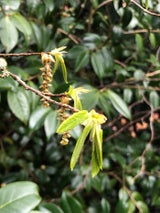- Plant IDs
- >
- ID By Type
- >
- Trees
- >
- Deciduous Trees
- >
- Carpinus japonica
Carpinus japonica
Common name: Japanese Hornbeam
Carpinus japonica, a broadleaf deciduous tree in the Birch family (Betulaceae), is native to central and southern Japan. It is noted for its graceful form, attractive foliage, and showy fruiting catkins. C. japonica is monecious. Male and female yellowish-green catkins appear in mid to late spring, turning pale brown as they mature. These catkins are sausage-shaped and have overlapping bracts. They are said to resemble hops.
C. japonica has mid-green, double serrated, lance-shaped leaves with prominent veins that give them a pleated appearance. In fall, the leaves turn golden yellow. The rotted leaves are good for improving the soil.
The genus name Carpinus is Latin and means hornbeam. The specific epithet means 'of Japan'. The common name hornbeam is derived from two Old English words, 'horn' meaning 'hard' and 'beam' meaning 'tree'.
C. japonica is not fussy about soil as long as the area is well-draining. The tree enjoys part shade but will tolerate full sun.
Carpinus japonica can be found in Bed 85A among the camellias and beautyberry, and across from the Meditation Garden. C. japonica was planted there in 2009. The photos show the tree as it appears in winter and spring.
Text and photos by Kumi Sutcliffe










